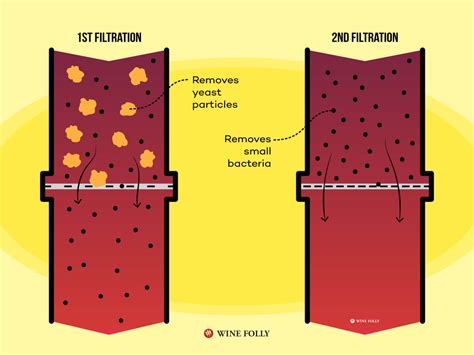How To Filter Wine
Ronan Farrow
Mar 24, 2025 · 3 min read

Table of Contents
How to Filter Wine: A Guide for Home Winemakers and Enthusiasts
Filtering wine might sound intimidating, but it's a crucial step in creating a high-quality, clear, and stable final product, whether you're a seasoned home winemaker or simply curious about the process. This guide breaks down the process, explaining why you might need to filter, the different types of filters, and how to choose the right one for your needs.
Why Filter Wine?
Wine filtering serves several important purposes:
Removing Unwanted Particles:
- Yeast: Unfiltered wine can contain dead yeast cells, which can contribute to cloudiness and off-flavors. Filtering effectively removes these particles, resulting in a clearer and brighter wine.
- Bacteria: Filtering helps remove bacteria that could lead to spoilage and undesirable changes in the wine's flavor and aroma. This is particularly important for extending the wine's shelf life.
- Tartrates: These naturally occurring crystals can sometimes form in wine, causing a hazy or cloudy appearance. Filtering can remove some, though other methods like cold stabilization are more effective.
- Other Sediment: During the winemaking process, various other small particles might end up in the wine. Filtering helps remove these impurities, improving clarity.
Improving Stability:
Filtering contributes to the overall stability of the wine, making it less susceptible to spoilage and degradation over time. This is especially important for wines intended for long-term aging.
Enhancing Appearance:
Let's be honest, a beautifully clear wine is more appealing to the eye. Filtering plays a key role in achieving this desirable aesthetic quality, enhancing the overall sensory experience.
Types of Wine Filters:
Several types of filters are available, each with its own strengths and weaknesses:
1. Pad Filters:
These are the simplest and most common type of filter used by home winemakers. They consist of a filtering pad (often cellulose-based) placed within a housing. They're effective at removing larger particles but may not remove all bacteria or smaller yeast cells.
2. Cartridge Filters:
These use disposable cartridges that contain a variety of filter media. They offer a broader range of filtration capabilities than pad filters, ranging from coarse to fine, depending on the cartridge used.
3. Membrane Filters:
These are the most sophisticated type of filter, capable of removing incredibly fine particles, including bacteria. They're often used for sterile filtration, ensuring a completely clear and microbially stable wine. However, they're also the most expensive option.
Choosing the Right Filter:
The type of filter you choose depends on your goals and the characteristics of your wine.
- For basic clarification: A pad filter is usually sufficient.
- For finer clarification and improved stability: Consider a cartridge filter with a finer pore size.
- For sterile filtration: A membrane filter is necessary.
The Filtering Process: (General Steps)
The specifics will vary depending on the type of filter used, but the general steps are as follows:
- Prepare your wine: Make sure your wine is free of large debris. You might need a preliminary coarse filtration before using a finer filter.
- Sanitize everything: Thoroughly sanitize your filter, housing, tubing, and any other equipment that will come into contact with the wine. This is crucial to prevent infection.
- Assemble your filter: Carefully assemble your filter according to the manufacturer's instructions.
- Filter the wine: Slowly pour the wine through the filter. Avoid forcing the wine through too quickly, as this can damage the filter and reduce its effectiveness.
- Bottle the filtered wine: After filtration, immediately bottle your wine to prevent recontamination.
Conclusion:
Filtering wine is a valuable technique that significantly impacts the quality, clarity, and longevity of your wine. By understanding the different filtering methods and choosing the right equipment, you can produce a superior final product that you can proudly share with others. Remember to always prioritize sanitation throughout the entire process.
Featured Posts
Also read the following articles
| Article Title | Date |
|---|---|
| How To Clean Mold Off Wood Deck | Mar 24, 2025 |
| How To Disable Knock Sensor | Mar 24, 2025 |
| How To Clean A Diesel Spill | Mar 24, 2025 |
| How To Get Rid Of A Squirrel Nest | Mar 24, 2025 |
| How To Dry Compression Shirts | Mar 24, 2025 |
Latest Posts
-
How Long Can You Keep A Brisket In A Cooler
Apr 05, 2025
-
How Long Can You Go Without A Dental Cleaning
Apr 05, 2025
-
How Long Can You Go With A Chipped Filling
Apr 05, 2025
-
How Long Can You Go With A Broken Bracket
Apr 05, 2025
-
How Long Can You Freeze Morel Mushrooms
Apr 05, 2025
Thank you for visiting our website which covers about How To Filter Wine . We hope the information provided has been useful to you. Feel free to contact us if you have any questions or need further assistance. See you next time and don't miss to bookmark.
